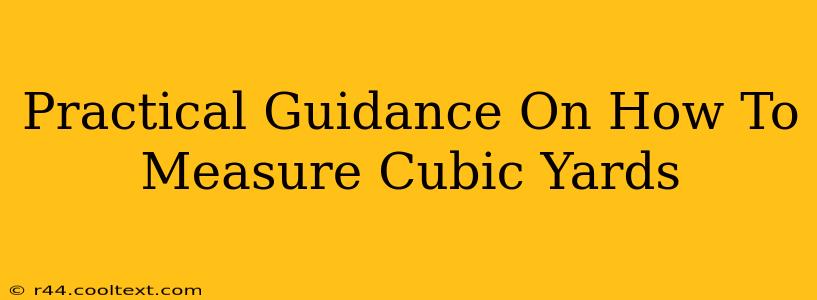Measuring cubic yards might seem daunting, but with the right approach, it becomes straightforward. Whether you're ordering gravel for landscaping, estimating concrete needs for a foundation, or tackling any project involving volume, understanding how to calculate cubic yards is crucial. This guide provides practical steps and examples to make the process easy.
Understanding Cubic Yards
A cubic yard is a unit of volume, representing a cube with sides measuring one yard (3 feet) each. This translates to 3 feet x 3 feet x 3 feet = 27 cubic feet. Therefore, one cubic yard contains 27 cubic feet. Understanding this conversion is key to accurate measurements.
Methods for Measuring Cubic Yards
Several methods exist depending on the shape of the space you're measuring:
1. Measuring Rectangular Spaces (e.g., a sandbox, foundation)
This is the simplest scenario. Follow these steps:
- Measure the length, width, and depth: Use a measuring tape to obtain the dimensions in feet. Ensure you're measuring in the same units consistently.
- Calculate the cubic feet: Multiply the length x width x depth. This gives you the volume in cubic feet.
- Convert cubic feet to cubic yards: Divide the cubic feet by 27 (since 1 cubic yard = 27 cubic feet).
Example:
Let's say you need to fill a rectangular sandbox with sand. The sandbox measures 10 feet long, 6 feet wide, and 1 foot deep.
- Cubic feet: 10 ft x 6 ft x 1 ft = 60 cubic feet
- Cubic yards: 60 cubic feet / 27 cubic feet/cubic yard = 2.22 cubic yards (approximately)
Therefore, you'll need to order approximately 2.22 cubic yards of sand. Always round up to ensure you have enough material.
2. Measuring Irregular Spaces (e.g., a pile of gravel, a irregularly shaped hole)
For irregular shapes, precise calculations are more challenging. Here are a couple of approaches:
-
Approximation using a rectangular shape: Try to approximate the irregular shape with a rectangle or a series of rectangles. This will provide an estimate. This is usually sufficient for bulk materials like gravel. Overestimating slightly is always recommended.
-
Volume Calculation using the average depth method: If possible, measure the area from top to bottom of the space. Divide the total into smaller parts, measure and calculate the cubic yards for each smaller section, and sum them up. This approach is more precise than the approximation above but requires careful measurements.
3. Using Online Calculators
Many online calculators are available to simplify the process. Simply input the dimensions, and the calculator will perform the conversion for you. These are excellent tools for verifying your calculations, especially for complex shapes. Remember to carefully verify the units used in the calculator.
Tips for Accurate Measurement
- Use accurate measuring tools: A reliable measuring tape is crucial for accurate results.
- Multiple measurements: Take multiple measurements at different points to account for irregularities in the shape. Average these measurements for a more accurate result.
- Account for compaction: Some materials, like gravel or soil, compact when placed. Factor this in by adding a slight extra amount to your calculations. This can vary by the material and specific project requirements.
- Round up: Always round up your cubic yard calculation to ensure you have enough material. It's better to have a little extra than to run short.
Conclusion
Calculating cubic yards doesn't have to be intimidating. By following these practical steps and choosing the appropriate method based on the shape of the space, you can accurately determine the volume needed for your project. Remember to always double-check your measurements and round up to ensure you have enough material to complete your job successfully.

